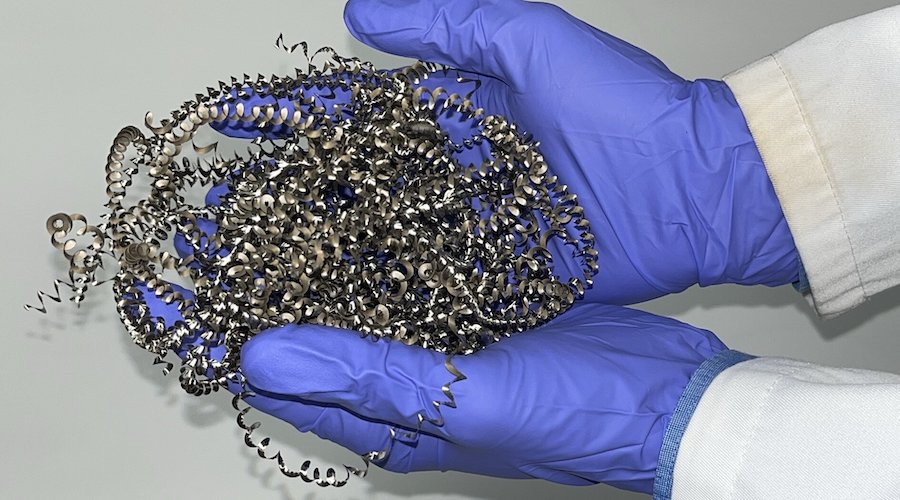Staff Writer | May 21, 2024 |

Waste metal swarf used in experiment to transform it into a highly efficient catalyst to make hydrogen from water, a discovery that could make hydrogen production more sustainable. (Image by the University of Nottingham).
A team of researchers from the University of Nottingham found a way to transform metal waste into a highly efficient catalyst to make hydrogen from water.

In detail, the scientists discovered that the surface of swarf, a byproduct of the metal machining industry, is textured with tiny steps and grooves on a nanoscale level. These textures can anchor atoms of platinum or cobalt, leading to an efficient electrocatalyst that can split water into hydrogen and oxygen.
“Industries in the UK alone generate millions of tons of metal waste annually. By using a scanning electron microscope, we were able to inspect the seemingly smooth surfaces of the stainless steel, titanium, or nickel alloy swarf,” said lead researcher Jesum Alves Fernandes. “To our astonishment, we discovered that the surfaces had grooves and ridges that were only tens of nanometers wide. We realized that this nanotextured surface could present a unique opportunity for the fabrication of electrocatalysts.”
The researchers used magnetron sputtering to create a platinum atom “rain” on the swarf’s surface. These platinum atoms then come together into nanoparticles that fit snugly into the nanoscale grooves.
“It is remarkable that we are able to produce hydrogen from water using only a tenth of the amount of platinum loading compared to state-of-the-art commercial catalysts,” said Madasamy Thangamuthu, a postdoctoral researcher at the University of Nottingham who was responsible for the analysis of the structure and electrocatalytic activity of the new materials. “By spreading just 28 micrograms of the precious metal over 1 cm² of the swarf, we were able to create a laboratory-scale electrolyzer that operates with 100% efficiency and produces 0.5 litres of hydrogen gas per minute just from a single piece of swarf.”
The group believes the electrocatalysts made from swarf have the potential to greatly impact the British economy. Thus, the scientists are partnering with AqSorption Ltd, a Nottingham-based company specializing in electrolyzer design and fabrication to scale up their technology.
“Our unique technology developed at Nottingham, which involves atom-by-atom growth of platinum particles on nanotextured surfaces, has solved two major challenges. Firstly, it enables the production of green hydrogen using the least amount of precious metal possible and, secondly, it upcycles metal waste from the aerospace industry, all in a single process,” Andrei Khlobystov, co-author of the study, said.
Hydrogen is a clean fuel that can be used to generate heat or power vehicles, and the only byproduct of its combustion is water vapour. However, most hydrogen production methods rely on fossil fuel feedstock. Electrolysis of water is one of the most promising green pathways for hydrogen production, as it only requires water and electricity.
The industry, however, is facing a challenge with water electrolysis, as this process requires rare and expensive elements like platinum to catalyze the water splitting. With the limited global supply and increasing prices of precious metals, there is an urgent need for alternative electrocatalyst materials to produce hydrogen from water.
No comments:
Post a Comment